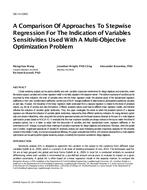Description
Global sensitivity analysis can be used to identify and rank variables importance (sensitivities) for design objectives and constraints, wherethe solution space is sampled and a linear regression model is normally adopted in the stepwise manner. The relative importance of variables can beexamined by three indicators: the order of variables entry into the linear regression model; the absolute values of the standardized regressioncoefficients or their rank transformation coefficients; and the size of the R2 changes (coefficient of determination) attributable to additional variablesat each step. However, the robustness of the linear regression model constructed from a stepwise regression is related to the choice of procedureoptions, e.g. the set of samples and data formulation. Different procedure options could lead to different linear regression models, and thereforeinfluence the indication of variables global sensitivities. Thus, this paper investigates the extent to which the procedure options of a stepwiseregression can influence the indication of variables global sensitivities, measured by three different sensitivity indicators, for energy demand, capitalcosts and solution infeasibility, when using both the randomly generated samples and the biased solutions obtained at the start of a multi-objectiveoptimization process (based on NSGA-II). It concludes that the most important variables are always ranked on the top no matter the choice ofprocedure options, but it is better to adopt both the entry-orders of variables and their standardized (rank) regression coefficients or thecontributions to R2 changes, to provide robust orderings of variables importance, for design objectives and constraints. Moreover, when the samplesize is smaller, re-generated separate set of samples for sensitivity analysis can avoid misleading variables importance, especially for the variablesranked in the middle. Finally, to improve computational efficiency, this paper concludes that the first 100 solutions obtained from a multi-objectiveoptimization can be used to perform global sensitivity analysis, to identify the important variables for design objectives.
Citation: ASHRAE Papers CD: 2014 ASHRAE Annual Conference, Seattle, WA
Product Details
- Published:
- 2014
- Number of Pages:
- 8
- File Size:
- 1 file , 1.1 MB
- Product Code(s):
- D-SE-14-C060




